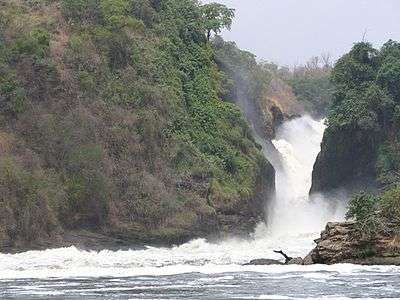Nero's exploration of the Nile river
The Roman exploration of the Nile River under Nero was a Roman attempt to reach the sources of the Nile river. It was organized by emperor Nero in 60/61 AD. How successful the expedition was is disputed by historians.

History
Emperor Nero around 61 AD sent a small group of praetorian guards to explore the sources of the Nile River in Africa. He did this in order to obtain information for a possible conquest of Ethiopia, as was called Equatorial Africa (and everything south of Egypt) by the Romans. The Roman legionaries navigating the Nile from southern Egypt initially reached the city of Meroë and later moved to the Sudd, where they found huge difficulties in going further.
Seneca wrote about this exploration and detailed that the sources were from a big lake in central Africa, south of the swamp region now called "the Sudd" in Southern Sudan. But other Roman historians, such as Pliny, suggest that the exploration was done in order to prepare a conquest of Ethiopia by Nero's legions.[1]
However the death of Nero prevented further explorations of the Nile as well as a possible Roman conquest south of their Roman Egypt[2].
Some historians suggest that the Roman legionaries of Nero probably reached the Murchison Falls in Uganda (but there it is a major controversy about this very difficult achievement).[3]
Seneca & Pliny accounts
Accounts are found in Seneca the Younger (VI.8.3) and Pliny (Natural History, VI.XXXV, p. 181-187):
The Roman legionaries navigating the Nile from southern Egypt initially reached the city of Meroe and later moved to the Sudd, where they found huge difficulties to go further.
From Meroe the Roman party travelled 600 miles up the White Nile, until they reached the swamp-like Sudd in what is now southern Sudan, a fetid wetland filled with ferns, papyrus reeds and thick mats of rotting vegetation.In the rainy season it covers an area larger than England, with a vast humid swamp teeming with mosquitoes and other insects.The only large animals in the Sudd were the crocodiles and hippos that occupied the muddy pools within its vast expanse. Those who entered this region had to endure severe heat and risk disease and starvation.The Sudd was discovered to be too deep to be crossed safely on foot, but its waters were also too shallow to be explored any further by boat.The Romans ‘reached an area where the swamp could only bear a small boat containing one person’.At this point the party despaired of ever finding a definite source for the Nile and turned back reluctantly to report their findings to the emperor in Rome. They had probably reached a position nearly 1,500 miles south of the Roman-Egyptian border. [4]
— Raoul McLaughlin
The small group of praetorian guards related -when back to Nero- that ‘We personally saw two rocks from which an immense quantity of water issued.’, according to Seneca. It is noteworthy to pinpoint that some historians -like Giovanni Vannini- argue that this place is the Murchison Falls in northern Uganda, meaning that the Romans reached equatorial Africa.
It is noteworthy to pinpoint that the Nero expedition from Roman Egypt reached the area of Jinja in Uganda, according to historian Vannini: he believes that the legionaries were able to reach lake Victoria, based on the description of their discovery of huge water falls. Vannini noted that in the Seneca interview to the legionaries, they described a Nile falls that is very similar to the Murchison Falls.
Seneca De Nubibus in the book Naturales Quaestiones, that gave details about a Nero expedition to the caput mundi investigandum (to explore the top of the world) in 61/62 AD. In this book he explained to have reported what two legionaries told him about their discovery of the caput Nili (the origin of the Nile river): "ibi vidimus duas petras, ex quibus ingens vis fluminis excidebat…ex magno terrarum lacu ascendere…" (We saw two huge rocks, from which the power of the [Nile] river went out in a powerful way.....[The Nile river] comes from a very huge lake of the [African] lands). Furthermore Seneca wrote that the legionaries told him that the water of the Nile river, that jumped through two huge rocks, was coming from a very big lake inside the African lands. This lake—according to Vannini and others—could only be the Victoria lake, the biggest African lake. The only river that goes out from this huge lake is the White Nile (named "Victoria Nile" when exits the lake), that in Jinja (Uganda) goes north toward the "Murchison Falls".
Indeed the "Murchison Falls" is a waterfall on the Nile that breaks the Victoria Nile, which flows across northern Uganda from Lake Victoria to Lake Kyoga and then to the north end of Lake Albert in the western branch of the East African Rift. At the top of Murchison Falls, the Nile forces its way through a gap in the rocks only 7 metres (23 ft) wide, and tumbles 43 metres (141 ft), then flows westward into Lake Albert.
The outlet of Lake Victoria sends around 300 cubic meters per second (11,000 ft³/s) of water over the falls, squeezed into a gorge less than ten metres (30 ft) wide: these falls are similar in shape to the ones described by the legionaries.
Indeed Vantini wrote in the magazine "Nigrizia" in 1996 that the legionaries did an explorative travel of more than 5,000 km from Meroe to Uganda: a remarkable achievement done using small boats in order to bypass the Sudd, a huge swamp full of dangerous Nile crocodiles.
Furthermore, another historian (David Braund) wrote in 2015 that probably Nero's expedition to the Nile's sources opened a new route toward the Indian Ocean, bypassing the dangers of piracy in the Red Sea area while allowing future Roman commerce toward India and Azania [5].
See also
References
- Buckley, Emma; Dinter, Martin (3 May 2013). A Companion to the Neronian Age. John Wiley & Sons. p. 364. ISBN 9781118316535.
- https://books.google.com/books?id=8OgVKbssrT0C&pg=PT364&lpg=PT364&dq=nero+expedition+to+ethiopia&source=bl&ots=Vzxhycd8WV&sig=Fvw5DFR8dcPV0z5W9YNkwMD6bpI&hl=en&sa=X&ved=0ahUKEwjwy4iniL_QAhUH7GMKHSidA0cQ6AEISDAG#v=onepage&q=nero%20expedition%20to%20ethiopia&f=false Buckley & Dinter: A Companion to the Neronian Age]
- Vantini, Giovanni (2004). Da dove viene l'acqua del Nilo? Ricerche e risposte di antichi scienziati. Piroga: volume 8, numero 23, pgs. 88-91 (url=http://www.volint.it/piroga/piroga10/nilo.pdf Archived 2018-01-14 at the Wayback Machine)
- Desert legionaries in Africa
- David Braund: Nero’s Nubian Nile, India and the rubrum mare (Tacitus, Annals 2.61)
Bibliography
- Emma Buckley, Martin Dinter. A Companion to the Neronian Age. Publisher John Wiley & Sons. Oxford, 2013 ISBN 1118316533
